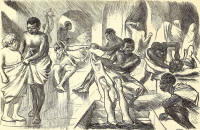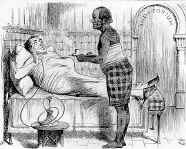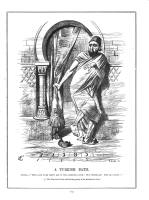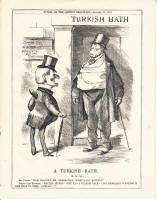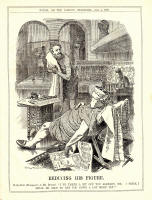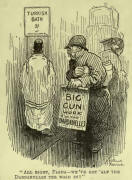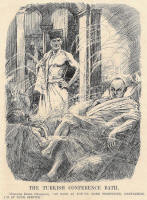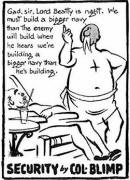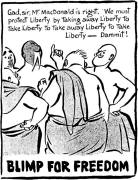3. Political cartoons
Charles Keene was a popular cartoonist whose work appeared in Punch between the 1850s and 1890s. His Turkish bath themed cartoon was published on 20 January 1866, a few weeks after the American Secretary of State proclaimed the final ratification of the Thirteenth Amendment to the Constitution, thereby making slavery illegal everywhere subject to United States Jurisdiction.
The caption, which linguistically would not be wholly acceptable today, sought to reassure readers that this was not a depiction of the torture chamber of the Inquisition, nor a representation of any alarming effects of the emancipation of American slaves, but 'merely the Turkish Bath in Latherington Street' in the West End of London.
Keene loosely based his drawing on the Jermyn Street Hammam, opened four years earlier, though without attempting to show Somers Clarke's actual building.
The Hammam was by far the largest Turkish bath in London at that time, and employed shampooers from north Africa. There was also a modesty code whereby bathers remained draped in towels until the last moment before entering the plunge pool, and they left it through a modesty tent of towels lowered around them from above.
Today, Keene's work is most likely to be known only by those with a special interest in caricature. But the work of John Tenniel is still widely recognised for his inimitable quirky illustrations for Lewis Carroll's Alice's adventures in Wonderland and its sequel Through the looking-glass. But in 1851, fourteen years before Alice, he joined Punch as a political cartoonist, later being made responsible for its weekly full-page political cartoon known as the Large Cut. He remained with Punch for fifty years, becoming one of the most important artists ever to work for the magazine.
On 7 October 1876, Tenniel's cartoon The Turkish bath was published. It was his first to use the heat of the Turkish bath, and its effect on those unaccustomed to it, as a metaphor for being in trouble politically or, as we might say today, being in hot water.
Attendant. "How do you feel after your bath, my Lord?"
Lord B... . "Pretty comfortable, thank you!—(Aside. Lost some weight, I fancy.)—You made it so confoundedly HOT for me !!!"
This appeared shortly after Gladstone had published a pamphlet describing the atrocities committed by Ottoman forces in subduing the Bulgarian uprising. He attacked Disraeli's government for turning a blind eye to the massacres so as not to weaken Turkey's rôle as a counterweight to the growing influence of Russia. The pamphlet sold 40,000 copies in a week,5 and 200,000 by the end of the month.'6
Readers familiar with Tenniel's illustrations for Alice's adventures in Wonderland will immediately recognise the similarity between Disraeli's hookah and that of the Caterpillar. And Martin Gardner has noted that his lion and unicorn in Through the looking-glass were widely believed to be caricatures of Gladstone and Disraeli.7
But what is especially interesting in this cartoon, from our point of view, is Tenniel's use of the Latin word Sudatorium over the entrance to the hottest room. For the subject of each Large Cut was chosen after often lengthy discussion at the magazine's weekly staff meeting held at the Punch table. Patrick Leary has described the constant attempt made during these discussions to ensure that cuts were within 'The limits of the imagined reader's understanding'.8
This would appear to imply that within twenty years of the introduction of the Turkish bath into Britain, readers, even if not themselves bathers, would be totally familiar with the bath, its Latin-named rooms, and the various processes of the bath culminating in the final period of relaxation—and this without such modern means of disseminating information as television and the social media which today we take for granted.
Tenniel returned to the Turkish bath on a number of occasions. On 22 August 1896, Punch published his cut referring to the Cretan Uprising that year. Under the Ottoman Empire, the island's 90% Christian majority were subjugated by an abusive Muslim governor. The Christians rose up, massacring their Muslim neighbours and, with the consequent involvement of the great powers, each with its own different aims, the hostilities led to the Greco-Turkish War of 1897.
A Turkish Bath
Sultan. 'They gave it me pretty hot in that Armenian room! But—Bismillah! This is—phew!!'
Leaving the hottest room labelled Crete, Sultan Abdul-Hamid II complains that he thought the earlier room, scene of the Armenian Massacres of 1894-1896 had been hot enough, but the room of the Cretan Uprising was even hotter.
It wasn't all war and massacres. Tenniel again used the Turkish bath as a metaphor for trouble in the issue of Punch dated 23 October 1875. But this time it was in the context of international finance—although the Ottomans were again in the line of fire.
A Turkish Bath
(In the City)
Mr Punch. 'Good gracious, Mr Jobberstock! What's the matter?'
Portly City Magnate. Matter, indeed! Just had a Turkish
bath! Lost thousands of pounds in less than no time! Pheugh!!!'
After the Crimean War, the Ottoman Empire had raised loans from English and French banks to enable them to finance the construction of railways. The terms of these loans were extremely favourable to the banks and it became increasingly difficult for the borrowers to reduce their debt. In October 1865 the Ottoman government declared a sovereign default on its loans, refusing to pay back the whole of the amount owing, and many in the City suffered losses as a result.
Tenniel wasn't the only cartoonist to make use of the homonyms £ (pound sterling) and lb (pound avoirdupois). In the cartoon Reducing his figure, another important Punch artist, Edward Linley Sambourne, also makes use of the double meaning of pounds, though more by implication than by spelling it out.
Sambourne's cartoon, published on 4 June 1902, comments on the year's budget just presented by the Chancellor of the Exchequer, Michael Edward Hicks Beach. The South African War, where costs soon soared to a pitch when they were virtually out of control and threatening a £60 million deficit, had earlier compelled Hicks Beach to raise income tax from 8d in the pound to one shilling. In the 1902 budget, he added a further penny and reintroduced a shilling duty on corn.
In Sambourne's cartoon, Hicks Beach, as shampooer, tells an exhausted Mr Budget that there's still a lot more he can take off.
Reducing his figure
H-CKS-B-CH (Shampooer, to Mr Budget). 'I've taken a bit off you already, sir. I think I shall be able to get you down a lot more yet.'
Linley Sambourne's diaries contain numerous references to his visits to Turkish baths, often on the way to or from the weekly Punch staff meetings.9 The Jermyn Street Hammam, Nevill's Northumberland Avenue establishment, and the Turkish baths at the Bath Club in Dover Street were amongst those he visited. F C Burnand, a later editor of Punch, was also a regular bather who, in 1861, had written a successful one act farce with Montagu Williams called The Turkish Bath.
One of David Urquhart's reasons for calling the hot dry-air bath Turkish, rather than Roman, was to encourage a wider appreciation of Turkish culture which he hoped would help persuade the British government to increase its support for the Ottoman Empire as a bulwark against an expanding Russia. So it is ironic that most political cartoons featuring Turkish baths are somewhat derogatory in their approach towards the Ottoman government.
'All right, Pasha—we've got 'alf the Dardanelles ter wash in!'
Especially was this so during the period of the 1914-18 War when the Dardanelles were being attacked by the British and their French allies. A cartoon published on 10 March 1915 by the less well-known Punch artist, Arthur Norris, portrays the animosity of a London newsvendor towards the totally innocent sandwich-board man advertising baths which had no more connection with anything Turkish than a Scotch egg has with Scotland or a Welsh rarebit with Wales.
After the war, the victorious allies attending the lengthy Lausanne Peace Conference found themselves facing not the originally intended representatives of the old defeated Ottoman Empire, but those of the new Turkish Republic which had abolished it.
Unlike Germany, which was to be punished for its rôle in the war and the events leading up to it by being made to pay reparations (the size of which contributed in large part to the rise of Hitler), the new Turkish Republic was treated with more respect. The boundaries of the modern state were recognised. Turkey relinquished claims on Cyprus and the Dodecanese islands; the Allies dropped their demands that Turkish Kurdistan should become autonomous, and that land should be ceded to Armenia.
In place of the jingoistic mockery of the wartime sandwich-board man, there was grudging admiration for the erstwhile enemy from at least one Punch cartoonist, Leonard Raven-Hill.
In his cartoon, The Turkish Conference Bath, published on 28 March 1923, the commanding self-confident shampooer, Mustapha Kemel Ataturk, addresses a tired-looking British Foreign Secretary, Lord Curzon, and a couple of dispirited Allied negotiators, telling them that he is ready when they are.
The Turkish Conference Bath
Mustapha Kemel (Shampooer). 'As soon as you've done perspiring, gentlemen, I'm at your service.'
By the 1930s, talk was once again about war—how to avoid it, or how to ensure the British won it. Cartoonist David Low first drew his Colonel Blimp character in 1934, a year after Hitler's rise to power. Blimp is a stereotypical jingoistic British military man living in his own vision of a Britain which was still fighting the first World War.
Low was reported to have developed the character after he overheard two army officers in a Turkish bath demanding that cavalry officers should be allowed to wear their spurs inside their new tanks.
This may or may not have been apocryphal. Nevertheless, all Low's Colonel Blimp cartoons are set in a Turkish bath. Two of them—one of which appears above in the section on shampooing—were included in A visit to the Turkish bath by Low and Terry (ie, Horace Thorogood), a booklet which for many years was given by Nevill's to their customers.
And Michael Powell and Emeric Pressburger's famous wartime film The life and death of Colonel Blimp has a wonderful scene set in a (studio-built, but accurately realistic) Turkish bath, where a group of 1940s soldiers enters and surprises the furious colonel and his cronies who are cooling down in the plunge pool.
Gad, sir, Lord Beatty is right. We must build a bigger navy than the enemy will build when he hears we are building a bigger navy than he's building.
Gad, sir, Mr MacDonald is right. We must protect Liberty by taking away Liberty to take Liberty to take away Liberty to take Liberty—Dammit!
Viewing just two examples of Low's other Blimp cartoons, readers might be forgiven for believing that nothing much has changed in the past eighty years.

